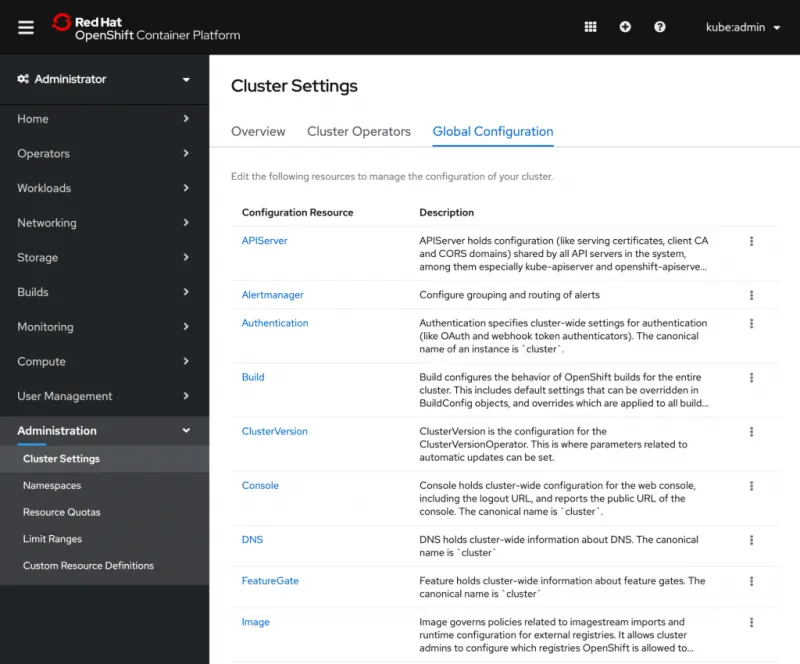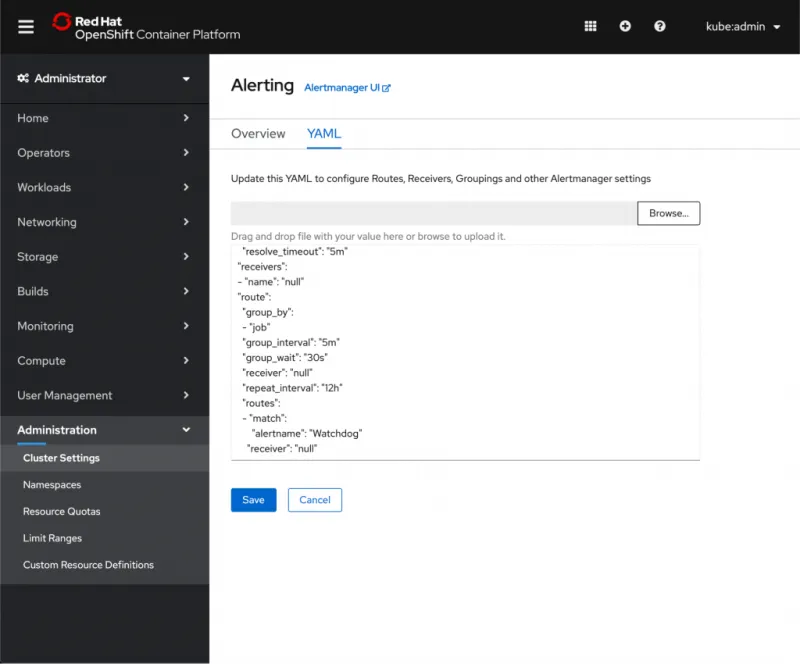Alerts are only useful if you know about them. That’s why we’re working on adding features to Red Hat OpenShift to make it easier for you to find out about potential problems and solve them before they become incidents. The new cluster overview dashboard is great for looking at the status of a cluster. But to get information when you might be away from your cluster, you’ll need to correctly configure your alerting system. One of the first things you should do when you set up a cluster is to use the tools described in this post. Without correct configuration you will not get critical alerts outside of the OpenShift console, and may miss out on features designed to reduce your mean time to resolution.
Alertmanager Configuration

OpenShift 4.3 contains a new Alertmanager section on the cluster settings page. The options it provides make it easier than ever to tell OpenShift’s monitoring tools how and where to send you notifications.

The first group is the alert routing settings. These fields determine how alerts are grouped into notifications and how long to wait before sending the notifications. Those notifications are then sent to Receivers that can be created and edited from the bottom of the page.
Receivers
Every OpenShift cluster needs a default receiver to handle any alerts not sent to other places. The default receiver that comes with a fresh install is initially very basic, so your first step should be to configure it to suit your needs. For more complex team structures, you may want to send different kinds of alerts to different places by creating more receivers. The easiest way to do this is to simply click the create receiver button. We currently offer forms for two types of receivers--webhook and PagerDuty--but more form types coming in the future.

Once you’ve entered the necessary details for the receiver, you can add some routing labels to decide which alerts will be sent there. For instance, you could send warning alerts to an email address and critical alerts to a specific Slack channel.

You can use these forms to create a robust alerting system. But for really complex configuration, it helps to go straight to the source. Switch to the YAML tab to view the raw version of your config and make any necessary changes. You can also use this view to create receiver types that are not currently supported by forms.
Information in the right places
Using the new Alertmanager configuration tools in OpenShift 4.3, you can direct alerts to the teams that need them--and avoid bothering teams that don’t. These features are part of an effort to make problem-solving in OpenShift simpler and reduce time to resolution. Follow along with the OpenShift Console and OpenShift Design GitHub repositories to see what new work is happening. If you’d like to provide feedback on any of the new 4.3 features, please take this brief 3-minute survey
À propos de l'auteur
Plus de résultats similaires
Key considerations for 2026 planning: Insights from IDC
Red Hat and Sylva unify the future for telco cloud
Edge computing covered and diced | Technically Speaking
Parcourir par canal
Automatisation
Les dernières nouveautés en matière d'automatisation informatique pour les technologies, les équipes et les environnements
Intelligence artificielle
Actualité sur les plateformes qui permettent aux clients d'exécuter des charges de travail d'IA sur tout type d'environnement
Cloud hybride ouvert
Découvrez comment créer un avenir flexible grâce au cloud hybride
Sécurité
Les dernières actualités sur la façon dont nous réduisons les risques dans tous les environnements et technologies
Edge computing
Actualité sur les plateformes qui simplifient les opérations en périphérie
Infrastructure
Les dernières nouveautés sur la plateforme Linux d'entreprise leader au monde
Applications
À l’intérieur de nos solutions aux défis d’application les plus difficiles
Virtualisation
L'avenir de la virtualisation d'entreprise pour vos charges de travail sur site ou sur le cloud
